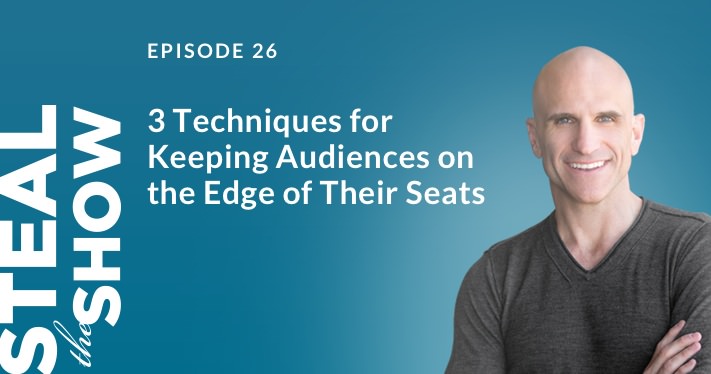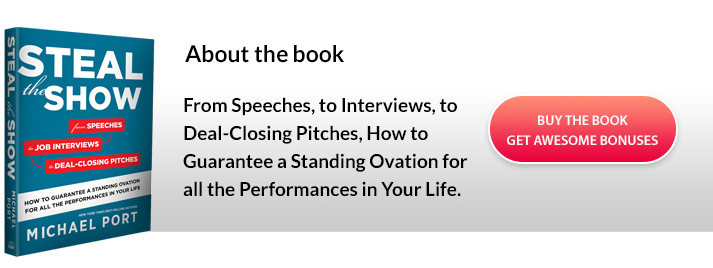00:00 Welcome to Steal the Show with Michael Port: From Speeches to Job Interviews to Deal-Closing Pitches, How to Guarantee a Standing Ovation For All the Performances in Your Life.
00:03 I am Michael, and here are three techniques for keeping audiences on the edge of their seats. Oh wait, but before I tell you that, if you want a copy of “Steal the Show”, you can go buy it anywhere books are sold. If you wanna get it with free bonuses you can go to stealtheshow.com, and if you like the sound of my voice, go get yourself the audio book, anywhere audio books are sold.
00:35 Now, techniques for keeping audiences on the edge of their seats. I’m gonna give you three now for our quick tips series. This particular strategy is building in contrast, and there are three different types of contrast that I’m going to introduce you to today, that you’re gonna wanna build into your entire performance, whether it’s negotiation, a sales call, an interview, a date, or a speech on a stage or in a hotel room. It’s something that playwrights, directors, actors, composers, musicians, photographers, and so many other artists have mastered, and now it’s time for you to do the same. It’s not a new concept, although it may be new to you. I really think it’s the secret weapon for producing creative and compelling content, and wowing an audience with your performance, and I discovered it while in graduate school at NYU, and it opened my eyes to what makes some performers fly high and others fall flat.
01:48 The purpose of using contrast when performing is simple and profound, to keep your audience engaged. So contrast is about intentionally building difference into your performances. It’s about doing the unexpected, and it keeps audiences on their toes. Now we know attention spans and expectations are shaped by all of the entertainment we see produced by the true masters of dramatic contrast in television, movies and drama, and then of course, influenced by the utter crap that we see all over the internet. Monotony bores your audience, but no one chooses to be monotonous. Many of us come to know and like our own material so well that we lose perspective about how an audience will respond, and unless you use contrast as an intentional strategy, you’ll run the risk of falling flat.
02:46 So for example, let’s just take vocal contrast for a moment. If this entire podcast, for every episode that I did, I sounded like this, “Hi, I’m Michael Port and I am going to do a podcast called “Steal the Show”. After a while you wouldn’t really wanna listen, even right now you’re going, “Stop, please. Michael, stop.” It would drive you nuts, you need vocal variety. You need contrast and pitch, pace, tone, et cetera. So, you see, you shape the writing, the content creation, the delivery, and all of the elements of your presentation. You look for areas to build in contrast of three different kinds: [1] Structural contrast, and that’s how you organize the material and use types of content. It’s about how you use stories, data, connecting narratives, and recommendations, that’s structural contrast. Then there’s emotional contrast, that’s [2]. That’s how an audience experiences your performance emotionally. It’s about how to strike different emotional notes: Serious, moving, hopeful, sad, sardonic. [3] Delivery contrast, that’s how you deliver the content physically, orally, visually. It’s about how you vary your vocal pitch, your tone, your timing as I said before, the pacing. It’s about how you changed up your visual elements and the speed of your movement on the stage and surrounding areas. It doesn’t matter if it’s a platform conference room or classroom.
04:44 So many of the choices you make will involve more than one type of contrast, but you have structural, emotional, and delivery. Now think about structural contrast in terms of how you arrange the elements of your content. So say you’re giving a speech at a sales conference. Now your passage about sales trends and statistics flows into a story about a sales rep in the field and the lesson she learned from a client that is then broken up by a joke before it transitioned into a major point about your department’s future direction. Then there’s emotional contrast. See ideally, you’ll take the audience on an emotional roller coaster ride, so the length, the pitch, and the drama of that ride will be determined in part by the type of speech you’re giving, and the type of audience in the house.
05:35 So if you’re giving a presentation to an audience of CFOs about a new approach to managing and presenting profit and loss data, you may not have geopolitical issues to contend with, but you might still have momentous and moving moments. You can still use emotional contrast through humor, with a good joke, about accountants, say, no offense, accountants, but there’s always a lotta food for fodder with jokes about accountants, and bald. By the way, I’m bald, baldness always works. I don’t know why, bald jokes are just funny, either people feel sorry for you because you’re bald, or there’s just something funny-looking about people who are bald. I don’t know what it is, but it always gets a laugh.
06:18 Now, you can still dramatize the importance of the work that accountants are doing, right? From an economic perspective with quotes and statistics, and by telling stories that that’s their pride in their work. You know who’s really good at this? Joe Biden, Vice President Joe Biden. Forget whether you like him politically or not, that’s not an issue. He’s a master of emotional contrast in his public performances. His ability and his willingness to shift from emotional tones is pretty remarkable. So he can be your slightly wacky but loving uncle at the swearing in of a new Senator, but then he can be the angry and stern COO of the free world vowing retribution against ISIS, and then he can switch quick, easily into the Frank Sinatra charmer on the campaign trail, so he knows how to reach his audience depending on who’s in the audience at that time.
07:15 Now there’s delivery contrast. It’s important to understand it conceptually first, because you’ll begin to see how often you can use delivery contrast, and really all types of contrast, to your advantage. And you can create delivery contrast when you’re performing by changing how you move in a space, how you use visuals, what kind of visuals, how you use auditory elements, in your voice of course, but simple sound effects or music. So we experience and deal with delivery contrast every day. In a relaxed conversation, say with a friend, our language and vocal quality effortlessly moves from story-telling to laughter, to must-hear details, to conspiratorial whispers. Our holiday offerings at Christmas and Hanukkah… By the way, you like how I said that very officially? Hanukkah, are staged with lights, with symbols, with songs and ritual. And when we wanna win a key point, say in a meeting, we might show contrast, by standing up and using the front of the conference room and a whiteboard.
08:21 My business partner and my fiancee, well depending on when you’re listening to this, she could be my wife, but she pairs up with me for our Heroic Public Speaking seminars, so we’re partners both in work and life. And I know that one of the reasons we’re successful as a team is because we have great delivery contrast. I wear black, she wears white. She has great hair, I have no hair. See once again, the bald jokes. My vocal quality is fast, it’s staccato; hers is melodious and measured. And I’m often described as fierce but very gentle, and she’s often described as loving but firm. And as business partners and co-presenters and co-teachers, she’s the performance yin to my yang.
09:07 Look, one of the reasons that I want you to read “Steal the Show”, I want you to pick up a copy of the book, is because I can tell you through this podcast what to do to be a remarkable performer, but you need to go deeper, because mastery requires full attention and full commitment. And even if you don’t have any desire whatsoever to be a professional speaker or even speak often, performing in the high-stake situations of your life will determine the quality of your life because how you handle and perform during those situations influence whether or not you succeed during those high-stake situations. So knowing what to do to be a better performer is a big part of your learning process. I also want you to consider checking out heroicpublicspeaking.com because in this format, or even in the book format, I can’t comment on your actual delivery, but if you come to one of our events, come to one of our courses, then we can, then we can work with you specifically, maybe even individually if it’s something you’re interested in, and we’ll help you stop speaking and start performing.
10:29 So the first place to start this journey for you is at stealtheshow.com, so you can buy a copy of the books. And in fact, when you’re there, we’ll give you, if you buy a few books, tickets to master class events around the country, we’ll give you video training programs for free. We’ll give you templates that you can use to create content and tell stories for free and much, much, more. So always incorporate emotional, structural and delivery contrast into your content and your presentations, and you’ll keep your audiences on the edge of their seat.
11:06 Keep thinking big about who you are and what you are for the world. This is Michael Port, signing off.








